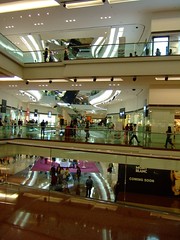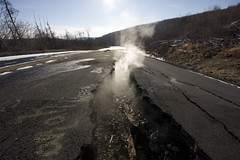It is East Kansas Agri-Energy’s ethanol facility, one of 100 or so such heartland garrisons in America’s slowly gathering battle to reduce its dependence on fossil fuels. The plant processes about 13 million bushels of corn to produce approximately 36 million gal. of ethanol a year. “That’s enough high-quality motor fuel to replace 55,000 barrels of imported petroleum,” the plant’s manager, Derek Peine, says. …
It takes five barrels of crude oil to produce enough gasoline (nearly 97 gal.) to power a Honda Civic from New York to California. …
Ethanol/E85
E85 is a blend of 85 percent ethanol and 15 percent gasoline. … A gallon of E85 has an energy content of about 80,000 BTU, compared to gasoline’s 124,800 BTU. So about 1.56 gal. of E85 takes you as far as 1 gal. of gas.
Case For: Ethanol is an excellent, clean-burning fuel, potentially providing more horsepower than gasoline. In fact, ethanol has a higher octane rating (over 100) and burns cooler than gasoline. However, pure alcohol isn’t volatile enough to get an engine started on cold days, hence E85. …
Cynics claim that it takes more energy to grow corn and distill it into alcohol than you can get out of the alcohol. However, according to the DOE, the growing, fermenting and distillation chain actually results in a surplus of energy that ranges from 34 to 66 percent. Moreover, the carbon dioxide (CO2) that an engine produces started out as atmospheric CO2 that the cornstalk captured during growth, making ethanol greenhouse gas neutral. Recent DOE studies note that using ethanol in blends lowers carbon monoxide (CO) and CO2 emissions substantially. In 2005, burning such blends had the same effect on greenhouse gas emissions as removing 1 million cars from American roads. …
One acre of corn can produce 300 gal. of ethanol per growing season. So, in order to replace that 200 billion gal. of petroleum products, American farmers would need to dedicate 675 million acres, or 71 percent of the nation’s 938 million acres of farmland, to growing feedstock. Clearly, ethanol alone won’t kick our fossil fuel dependence–unless we want to replace our oil imports with food imports. …
Biodiesel
Fuels for diesel engines made from sources other than petroleum are known as biodiesel. Among the common sources are vegetable oils, rendered chicken fat and used fry oil. …
Case For: Modern diesel engines can run on 100 percent biodiesel with little degradation in performance compared to petrodiesel because the BTU content of both fuels is similar–120,000 to 130,000 BTU per gallon. In addition, biodiesel burns cleaner than petrodiesel, with reduced emissions. Unlike petrodiesel, biodiesel molecules are oxygen-bearing, and partially support their own combustion.
According to the DOE, pure biodiesel reduces CO emissions by more than 75 percent over petroleum diesel. A blend of 20 percent biodiesel and 80 percent petrodiesel, sold as B20, reduces CO2 emissions by around 15 percent.
Case Against: Pure biodiesel, B100, costs about $3.50–roughly a dollar more per gallon than petrodiesel. And, in low temperatures, higher-concentration blends–B30, B100–turn into waxy solids and do not flow. Special additives or fuel warmers are needed to prevent fuel waxing. …
Electricity
Case For: Vehicles that operate only on electricity require no warmup, run almost silently and have excellent performance up to the limit of their range. Also, electric cars are cheap to “refuel.” At the average price of 10 cents per kwh, it costs around 2 cents per mile. …
A strong appeal of the electric car–and of a hybrid when it’s running on electricity–is that it produces no tailpipe emissions. Even when emissions created by power plants are factored in, electric vehicles emit less than 10 percent of the pollution of an internal-combustion car.
Case Against: Pure electric cars still have limited range, typically no more than 100 to 120 miles. In addition, electrics suffer from slow charging, which, in effect, reduces their usability….
And then there’s the environmental cost. Only 2.3 percent of the nation’s electricity comes from renewable resources; about half is generated in coal-burning plants.
Hydrogen
Hydrogen is the most abundant element on Earth, forming part of many chemical compounds. Pure hydrogen can be made by electrolysis–passing electricity through water. This liberates the oxygen, which can be used for many industrial purposes. Most hydrogen currently is made from petroleum.
Case For: Though hydrogen can fuel a modified internal-combustion engine, most see hydrogen as a way to power fuel cells to move cars electrically. The only byproduct of a hydrogen fuel cell is water.
Case Against: … And, despite the chemical simplicity of electrolysis, producing hydrogen is expensive and energy consuming. It takes about 17 kwh of electricity, which costs about $1.70, to make just 100 cu. ft. of hydrogen. That amount would power a fuel cell vehicle for about 20 miles.

